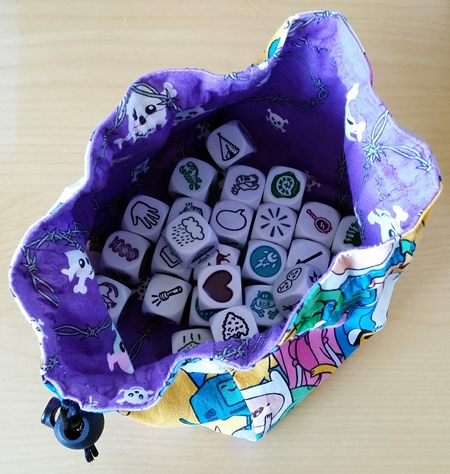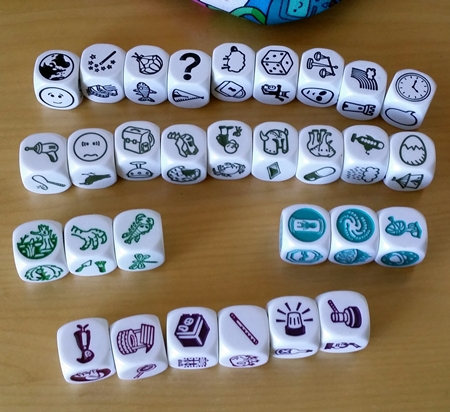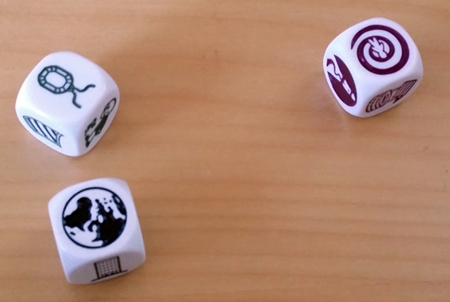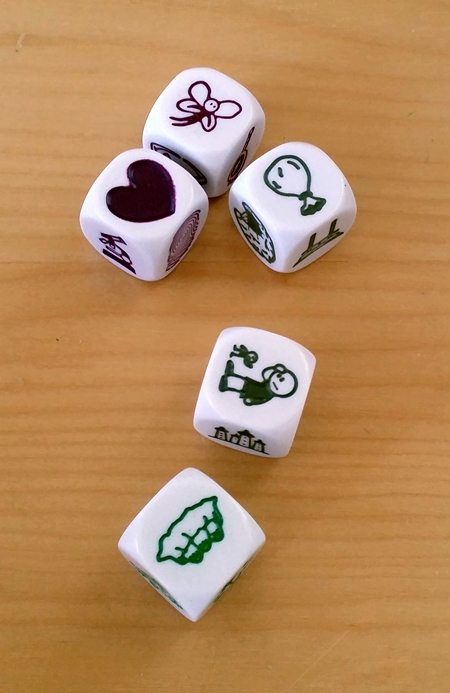This Adventure Time dice bag rides in my gaming bag every day, just in case. What’s inside?

Why, it’s a big ol’ pile of Rory’s Story Cubes (paid link)!

I carry these to every game because they’re one of the most useful improv tools in my GMing toolkit.
Here’s my full assortment:

That spread includes the following Story Cubes sets (also noted is where they appear in the above photo; all are paid links):
- Original (top row)
- Voyages (second row)
- Prehistoria (third row, left)
- Intergalactic (third row, right)
- Enchanted (bottom row)
- Clues (bottom row)
I don’t find every Story Cubes set to be perfect for improv GMing — Actions (paid link), for example, doesn’t really meet my needs (but it might meet yours; YMMV, and all that). There are also newer sets I haven’t considered, but I worry that having too many dice in this bag would dilute some of its potency; this amount is a good fit for me.
What I love about Story Cubes
These dice are well-made: a nice size, tumbled, etched, and well-inked. They’re easy to read, even for my aging eyes.
The symbols are whimsical, but also tuned for what I find to be an interpretive sweet spot: It’s a dinosaur, but that can mean a literal dino, an old person, someone with antiquated habits, a museum, an archaeological dig site — and so on.
That interpretive sweet spot applies just as well when rolled together — better, even. The instant context provided by the rest of the roll, and my imagination, makes different meanings pop out at me.
Three examples
The most common thing I do with my Story Cubes is reach into the bag, grab a handful (no specific amount) of dice, roll them, and just look at the results for a moment. I generally do this when I need a jolt — perhaps I’m feeling stuck, or I’m considering an element of the game that I hadn’t considered before, and some random inspiration seems like it would help.
That’s totally unscientific! But it works for me.
But I sometimes use them for more specific things — like coming up with NPCs (which I wrote about on Gnome Stew three years ago).
I usually use three dice for NPCs, drawn at random from my full mixed set. Here’s a sample throw:

That could be: a planar traveler who uses a magic gemstone to slip into other worlds, a globetrotting hypnotist, someone under the influence of a cursed jewel (ignoring the globe; I often do this if I can’t use every die in a throw), and so on.
Three dice gives me enough to work with, but doesn’t overwhelm me with details to think about. (An especially important NPC might merit more than three dice.)
I also like to use them to think about what’s going on with [X], whatever X might be at the moment — a conspiracy, a faction’s agenda, a mystery, etc. For those throws, I generally use at least five dice, and occasionally more than five. Here’s a five-die throw:

The first thing I thought of was an adventure hook: giants are using enchanted bees to put people to sleep so they can steal their treasure. I read the dinosaur eggs as sleeping babies when I first saw that die, and interpreted the heart to mean that this was a charming, Disney-esque plot rather than a more serious one.
If you looked at those throws and started getting ideas for an NPC or other game element, then you’ll probably like Story Cubes.
A security blanket
Lastly, I like just having Story Cubes nearby when I’m GMing, because I know they’re there if I need them. Zero-prep GMing still makes me nervous sometimes (and I suspect it always will), so knowing I’ve got a proven, useful tool for getting back into the groove — or finding the groove, or unsticking my brain — in my gaming bag is comforting.
And that’s one of the coolest things about Rory’s Story Cubes (paid link): They have a million gaming applicatons. Throw in being inexpensive and well-made, and they’re incredibly easy to recommend.

I just found out that there were Doctor Who Story Cubes at SDCC. Now my life isn’t complete.
I’d enjoy using the strongly IP-themed ones for games in those universes, I suspect. Doctor Who would be especially well-suited to this kind of improv, too.